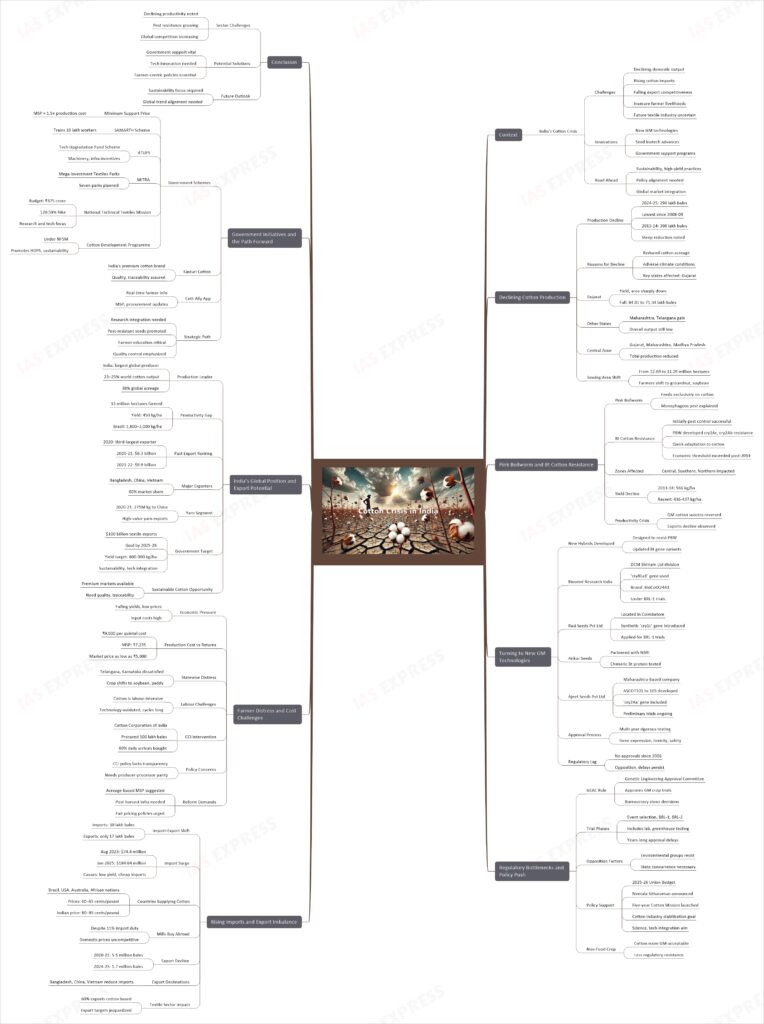India’s Cotton Crisis: Challenges, Innovations and the Road Ahead

From Current Affairs Notes for UPSC » Editorials & In-depths » This topic
IAS EXPRESS Vs UPSC Prelims 2024: 85+ questions reflected
In light of recent headlines highlighting India’s rising cotton imports and falling domestic output, the cotton sector is facing an emergency. Once a dominant global exporter, India is now struggling to sustain production levels, forcing a re-evaluation of farming practices, seed technology, and export competitiveness. The future of millions of farmers and the textile industry hangs in the balance.

Declining Cotton Production: A Grim Trend
- India’s cotton production in the marketing year 2024-25 is projected at 294 lakh bales, the lowest since 2008-09. This marks a steep fall from the 398 lakh bales produced in 2013-14.
- The decline is primarily due to reduced acreage under cotton cultivation and adverse climatic conditions, particularly in key producing states like Gujarat.
- Gujarat, once the highest producer, has seen a drastic fall in both yield and area sown. The latest figures suggest a drop from 84.01 lakh bales to 71.34 lakh bales.
- Other states such as Maharashtra and Telangana have witnessed minor gains due to favourable conditions, but overall national output remains concerning.
- The Central Zone (Gujarat, Maharashtra, Madhya Pradesh), which contributes the most to India’s cotton production, has reported a noticeable drop in total output.
- Sowing area has fallen from 12.69 million hectares last year to 11.29 million hectares, as more farmers shift to groundnut and soybean due to better returns.
Pink Bollworm and Bt Cotton Resistance
- The pink bollworm (PBW), a monophagous pest feeding only on cotton, is a major contributor to the decline in yields.
- Though Bt cotton hybrids initially controlled this pest, over time PBW developed resistance, particularly to the cry1Ac and cry2Ab toxins.
- Resistance buildup occurred because PBW feeds exclusively on cotton, allowing it to adapt quickly across multiple generations in a single growing season.
- From 2014 onwards, reports emerged of PBW surpassing the economic threshold level, first in the Central Zone, followed by the Southern and Northern Zones.
- As a result, India’s per-hectare cotton yield fell from 566 kg in 2013-14 to around 436-437 kg in recent years.
- The pest infestation has turned a previous success story of GM cotton into a crisis, with productivity levels stagnating and exports declining.
Turning to New GM Technologies
- In response to the pink bollworm menace, Indian seed companies are developing new genetically modified (GM) cotton hybrids with fresh Bt gene variants aimed at combating resistance.
- Bioseed Research India, a division of DCM Shriram Ltd, has created a hybrid using the ‘cry8Ea1’ gene under the brand BioCotX24A1. This variety is undergoing Biosafety Research Level-1 (BRL-1) trials across multiple states.
- Rasi Seeds Pvt Ltd, based in Coimbatore, has introduced a new synthetic ‘cry1c’ gene to improve resistance to PBW and has applied for BRL-1 trials.
- Ankur Seeds has partnered with the National Botanical Research Institute (NBRI) to trial a chimeric Bt protein (a hybrid of multiple Bt genes), which offers potentially stronger and longer-lasting resistance.
- Ajeet Seeds Pvt Ltd, from Maharashtra, has developed GM cotton lines ASCOT101 to 105, featuring the ‘cry2Aa’ gene, and is conducting preliminary trials.
- These hybrids must undergo rigorous multi-year testing for gene expression, environmental safety, toxicity, and pollen flow before any commercial release.
- Despite the urgent need, no new GM cotton variety has been approved since 2006, owing to regulatory delays and opposition from environmental groups.
Regulatory Bottlenecks and Policy Push
- The Genetic Engineering Approval Committee (GEAC) plays a key role in clearing GM crop trials but is often bogged down by bureaucratic procedures and state-level permissions.
- Field trials—event selection, BRL-1 and BRL-2—along with laboratory and greenhouse testing, are lengthy processes, often stretching over multiple years.
- Opposition from environmental groups and the requirement for state government concurrence further complicate the path for GM crop approvals.
- However, the gravity of the current crisis has sparked renewed policy interest. In her 2025-26 Union Budget, Finance Minister Nirmala Sitharaman announced a five-year Cotton Mission, aimed at using “the best of science and technology” to support cotton farmers and stabilize supply for the textile industry.
- The mission may offer the much-needed policy boost for newer GM cotton events, especially since cotton is a non-food crop, which makes it more acceptable for genetic modification from a regulatory standpoint.
Rising Imports and Export Imbalance
- For the first time in years, India’s cotton imports are set to exceed its exports. Imports are projected at 30 lakh bales, while exports may fall to just 17 lakh bales.
- Import volumes have risen sharply: from $74.4 million in August 2023 to $184.64 million in January 2025, according to trade data. This surge is attributed to lower domestic yields and cheaper international prices.
- Countries like Brazil, the U.S., Australia, and African nations are offering cotton at prices significantly lower than India’s. For example, Brazilian cotton sells at 60-65 cents/pound, compared to 80-85 cents/pound for Indian cotton.
- Indian textile mills are buying from global markets despite an 11% import duty, due to uncompetitive domestic prices and quality concerns.
- India’s cotton exports have declined steadily from 5.5 million bales in 2020-21 to an expected 1.7 million bales in 2024-25.
- Export destinations like Bangladesh, China, and Vietnam—previously major importers of Indian cotton—are now turning to cheaper suppliers, reducing India’s global market share.
- This reversal has major implications for India’s textile export targets, especially as 60% of garments exported are cotton-based.
Farmer Distress and Cost Challenges
- Many cotton farmers are disillusioned due to falling yields, low prices, and high input costs. The cost of production per quintal is about ₹9,000, while the minimum support price (MSP) is ₹7,235. In open markets, prices sometimes drop as low as ₹5,000.
- States like Telangana and Karnataka report widespread dissatisfaction among farmers. Many are shifting to crops like soybean and paddy, which demand fewer resources and offer quicker returns.
- The labour-intensive nature of cotton farming, outdated technology, and long crop cycles are pushing farmers away from this once-lucrative crop.
- The Cotton Corporation of India (CCI) has stepped in to procure around 100 lakh bales under MSP to stabilize prices, buying nearly 60% of daily arrivals at the peak of the season in December 2024.
- Despite this support, concerns remain. The CCI’s procurement and sale policy needs more transparency and flexibility to ensure fair prices for both producers and processors.
- Industry leaders are calling for reforms like acreage-based MSP, better post-harvest infrastructure, and policies that ensure price parity for farmers.
India’s Global Position and Export Potential
- India is the largest cotton producer in the world, contributing 23–25% of global cotton output, and has 38% of the world’s cotton acreage. Yet, its productivity lags far behind global leaders like Brazil and the U.S.
- Despite a massive cultivation area of over 13 million hectares, India produces less due to lower per-hectare yields—around 450 kg lint/ha, compared to 1,800–2,000 kg/ha in Brazil.
- India was the third-largest exporter of raw cotton globally in 2020, with exports valued at US$ 6.3 billion in 2020-21 and US$ 9.9 billion between April 2021–February 2022.
- Major importers of Indian cotton include Bangladesh, China, and Vietnam, which together account for 60% of exports. However, their shift to alternate suppliers due to pricing issues threatens India’s hold on these markets.
- The cotton yarn segment also plays a critical role, with India exporting large volumes to China and Bangladesh. In 2020-21 alone, China imported 275 million kg of cotton yarn from India.
- The Government of India has set an ambitious target of $100 billion in textile exports by 2025-26 and seeks to increase cotton productivity to 800-900 kg/ha using advanced farming practices and technology integration.
- With the global trend leaning towards sustainable and organic cotton, India has the opportunity to expand in premium markets—if quality, yield, and traceability improve.
Government Initiatives and the Path Forward
- Several government schemes have been launched to uplift the cotton sector:
- Minimum Support Price (MSP): Calculated as 1.5 times the cost of production to ensure minimum farmer income.
- SAMARTH: A scheme to train 10 lakh people for employment in the textile sector.
- Technology Upgradation Fund Scheme (ATUFS): Offers incentives for adopting modern machinery and infrastructure.
- MITRA (Mega Investment Textiles Parks): Aims to set up seven textile parks over three years to boost exports, employment, and competitiveness.
- National Technical Textiles Mission: With a budget hike of 120.59% to ₹375 crore, this mission focuses on boosting research and technical capacity.
- Cotton Development Programme under NFSM: Targets improved yield through demonstration of High-Density Planting Systems (HDPS) and sustainable practices.
- The launch of Kasturi Cotton—India’s premium cotton brand—aims to strengthen global recognition, quality assurance, and traceability for Indian cotton.
- The Cott-Ally mobile app provides real-time updates to farmers about MSP, procurement centers, and other advisory services.
- India must embrace a multi-layered strategy: integrating research, pest-resistant seeds, quality controls, and farmer education to transform its cotton economy.
Conclusion
India’s cotton sector, though vast and critical to the national economy, is battling declining productivity, pest resistance, and global competition. However, with proactive government support, technological innovation, and farmer-centric policies, the country can overcome these setbacks. The future of India’s cotton industry lies in sustainable, high-yield practices and strategic alignment with global market trends.
UPSC Practice Questions (250 words)
- What are the main reasons for India turning from a net exporter to a net importer of cotton in recent years?
- Evaluate the impact of India’s cotton policies and government schemes on boosting productivity and improving export competitiveness.
If you like this post, please share your feedback in the comments section below so that we will upload more posts like this.

